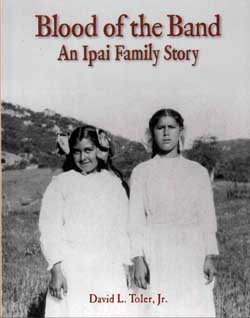Blood of the Band: An Ipai Family Story by David L. Toler, Jr.; Sunbelt Publications, © 2015; ISBN 978-1-941384-12-1; 285 pages, including index; $19.95.
By Donald H. Harrison

 SAN DIEGO –This is a story of the San Pasqual band of Ipai Indians. The Ipai are the western branch of the Kumeyaay Nation, as opposed to the Tipai who occupy farther eastern San Diego County, Imperial County and parts of Baja California. The history is told through the eyes of the Trask family, and the various branches of that family, which have occupied the San Pasqual area of the county since the early 20th century. The author, David L. Toler, Jr., is a descendant of Frank Trask, whose father, Roswell Task, was a white settler, and whose mother was reportedly a San Pasqual Ipai, name now unknown, believed to have died in 1867 during childbirth. Frank married Leonora La Chappa in 1902, and in 1910 was appointed by the federal government as a judge of the San Pasqual Indian Reservation, a position reserved for tribal members.
SAN DIEGO –This is a story of the San Pasqual band of Ipai Indians. The Ipai are the western branch of the Kumeyaay Nation, as opposed to the Tipai who occupy farther eastern San Diego County, Imperial County and parts of Baja California. The history is told through the eyes of the Trask family, and the various branches of that family, which have occupied the San Pasqual area of the county since the early 20th century. The author, David L. Toler, Jr., is a descendant of Frank Trask, whose father, Roswell Task, was a white settler, and whose mother was reportedly a San Pasqual Ipai, name now unknown, believed to have died in 1867 during childbirth. Frank married Leonora La Chappa in 1902, and in 1910 was appointed by the federal government as a judge of the San Pasqual Indian Reservation, a position reserved for tribal members.
Readers learn of Kumeyaay creation legends, about what anthropologists say about the lives of the Ipai prior to European contact, and then are taken on a journey through more modern history: The Mission period when many Indians converted to Catholicism under the influence of Franciscan missionaries; the Mexican period when the missions were secularized and Indians scattered; the early American period when treaties were made and broken in favor of land-hungry white settlers; the later American period when reservations were established; the 1920s when Indians were granted full American citizenship; and subsequent periods of flux when Congress at one point desired to terminate reservations, and later decided to reinforce them. San Pasqual, in the political cross currents, was moved from one location to another, off the Ipai’s ancestral lands and onto the lands of neighboring Indians.
Some Ipai declined to live on the reservations, retreating to inaccessible inland areas. Others initially lived on the reservations, and then left to live in the cities of San Diego County. However, they later returned when being counted as a member of the tribe brought with it not poverty but the new possibility of financial rewards, either through compensation if the land were condemned by the federal government, or through profit from gaming and other business enterprises on the reservations.
As a Jewish reader, I found three interesting points of intersection between the history of the
San Pasqual band and the history of the Jews.
We all know the Jewish biblical creation story involving Adam and Eve, and a talking snake who persuaded Eve to take a bite from the forbidden fruit from the Tree of Knowledge.
A snake figures in the Ipai creation story as well. As recited by Jose Bastiano LaChappa, and published within Toler’s book:
The people planned a ceremony, and built a large enclosure of brush. Then they sent a messenger to bring the great serpent Umaihuhlya-wit (“sky moon”) from the ocean. He came and coiled himself in the enclosure but he could not get his entire length inside. On the third morning, when he had coiled as much of his body as the enclosure would contain, the people set fire to it and burned him. His body exploded and scattered. Inside his body was all knowledge, comprising songs, magic secrets, ceremonies, languages, and customs. Thus these were scattered over the land and different people acquired different languages and customs.
In our Jewish culture, the snake put one over us humans, though it paid the consequences later. In the Ipai tradition, humans got the better of the snake. But in both instances, mankind was exposed to knowledge.
I winced at the next reference, which drew an analogy between the Israelites conquering the Land of Canaan on the instructions of God, and white Christians appropriating Indian land by what they considered divine right. Toler’s account quoted Native American historian Steve Newcomb of Shawnee/ Lenape background, as opining:
An explanation … is that for the Christian colonizers of the Americas, the Chosen People-Promised Land cognitive model was the basis for drawing an analogy between the lands of North America and the lands of Canaan in the Old Testament. This entails the lands of North America being conceived of as “land free to be taken.”
Finally, I found in the testimony of Julie Holder, a Native American, an analogy to another experience in Jewish history: the Holocaust.
Toler quoted her as saying:
Now the issue has become, “Who is really Indian”? The reservation Indians resent the Urban Indians returning only to take advantage of the current opportunity of abundance. So now you must prove you are an Indian. Genocide is the deconstruction of cultures. The American government has forged this deconstruction onto the American Indian people since 1846. Not only were Indians not citizens until 1924, but our history, births, deaths and responsibility was in the Department of War until the termination act. This left Indian people without historic documented and validated identity; we were the original enemy combatants and have been historically treated as such. Outside of the Jewish people in Nazi Germany, the Indian people are the only race required to prove their degree of Indian blood. How much pure blood one carries can be equated to the genocide of the Jews with Hitler’s need to prove, “how much Jewish blood was carried by each individual Jew.” The product of this demand was Hitler’s excuse and his foundation for genocide.
Personally I found Toler’s analogy distressing. It seems to me the two situations are easily distinguishable. In Hitler’s Germany, anyone with one-quarter Jewish blood, that is a single grandparent, was liable to be categorized as a Jew and sent to a concentration camp. In the case of Indians, as little as one-sixteenth Indian blood enables one to establish oneself as a member of an Indian nation. In the Jewish case, a slight percentage meant imprisonment and death; in the native American case, a slight percentage could lead, depending on the rules of the tribe, to economic benefits.
*
Harrison is editor of San Diego Jewish World. He may be contacted via donald.harrison@sdjewishworld.com
Pingback: How Campaign to Elect Pope Francis Was Managed – canada christian
Pingback: Sunbelt Publications : Blood of the Band: An Ipai Family Story